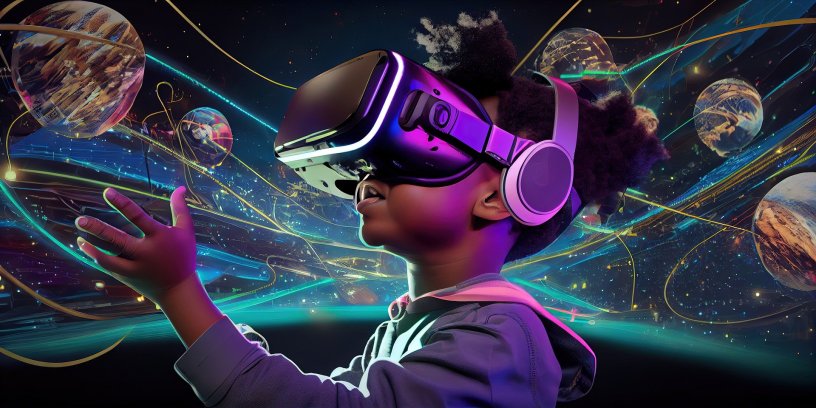The concept of a Metaverse, a virtual world where users can interact with each other and digital objects in a seamless manner, has been around for many years. However, recent advancements in technology have made it a more realistic possibility than ever before. The emergence of blockchain technology and virtual reality (VR) has paved the way for the creation of a truly immersive and interactive Metaverse. In this article, we will explore what the Metaverse is, how it works, and its potential impact on society.
Table of content:
What is the Metaverse?
Metaverse is a combination of the prefix “meta,” meaning “beyond,” and the word “universe.” Thus, it refers to a space that transcends the physical world, which is populated by virtual entities created by humans. Metaverse is a shared space created by the convergence of physical and virtual worlds, where people can interact, engage, and transact with each other in a virtual environment.
Metaverse is not just a single platform or application. Instead, it is an ecosystem of interconnected virtual worlds and environments that enable people to engage with each other and transact using digital assets, such as cryptocurrencies and NFTs. The idea behind Metaverse is to create a virtual world that is as immersive and interactive as the real world, enabling individuals to have similar experiences as they would in the physical world.
The Metaverse is essentially a collective virtual shared space that is created by the convergence of physical and virtual reality. It is a fully immersive digital environment that can be accessed through virtual reality headsets, computers, or mobile devices. The Metaverse is not limited to a single platform, but rather is made up of various interconnected virtual worlds.
How Does the Metaverse Work?
Metaverse works by creating a virtual world that is accessible to anyone with an internet connection and the necessary equipment, such as a VR headset or AR-enabled device. Metaverse technology enables users to create their virtual representations, known as avatars, that can interact with other avatars in the virtual environment.
Metaverse environments can be created by individuals, businesses, or organizations, and they can be customized according to their needs. The virtual environment can be used for a variety of purposes, such as gaming, education, socializing, and commerce. Metaverse technology also enables the creation of digital assets, such as cryptocurrencies and NFTs, that can be used for transactions within the virtual world.
The Metaverse is built on blockchain technology, which enables secure and transparent transactions between users. Each user has a digital identity that is tied to their personal blockchain address, which allows them to securely own and trade digital assets within the Metaverse. Digital assets can include virtual real estate, clothing, and even virtual pets.
The Metaverse is also powered by VR technology, which creates a fully immersive and interactive environment for users. Users can navigate the Metaverse through their virtual avatars, which can be customized to reflect their real-life identities or whatever they choose.
Real-World Examples of Metaverse
Some of the notable examples of Metaverse are:
- Second Life: Second Life is a virtual world that was created in 2003. It’s an online platform that enables individuals to create their virtual representations and interact with others in the virtual world. Second Life has a robust economy with a virtual currency, Linden Dollars, that can be used for transactions within the virtual world.
- Decentraland: Decentraland is a blockchain-based virtual world that enables users to create, experience, and monetize content and applications. Decentraland uses Ethereum blockchain to create digital assets that can be bought, sold, and traded within the virtual world.
- Fortnite: Fortnite is a popular online game that has become a cultural phenomenon. The game has a virtual world that allows players to engage with each other, build structures, and participate in various activities.
Potential Impact on Society
The Metaverse has the potential to revolutionize the way we interact with each other and with digital content. It could enable entirely new forms of social interaction, entertainment, and commerce. For example, people could attend virtual concerts, shop for virtual clothing, or even attend virtual schools.
The Metaverse could also have a significant impact on the economy. With the ability to own and trade digital assets securely, the Metaverse could create entirely new markets and industries. For example, virtual real estate could become a valuable asset in the Metaverse, with users buying and selling virtual land just like they do in the real world.
However, the emergence of the Metaverse also raises questions about privacy, security, and regulation. How will user data be protected in the Metaverse? How will virtual crimes be policed? How will taxation work in the Metaverse? These are all important questions that will need to be addressed as the Metaverse becomes a more prevalent part of society.
Conclusion
The Metaverse represents an exciting new frontier in digital technology. It has the potential to create entirely new forms of social interaction, entertainment, and commerce. However, as with any new technology, there are also potential risks and challenges that will need to be addressed. It will be up to developers, policymakers, and society as a whole to ensure that the Metaverse is a safe and equitable space for everyone.
